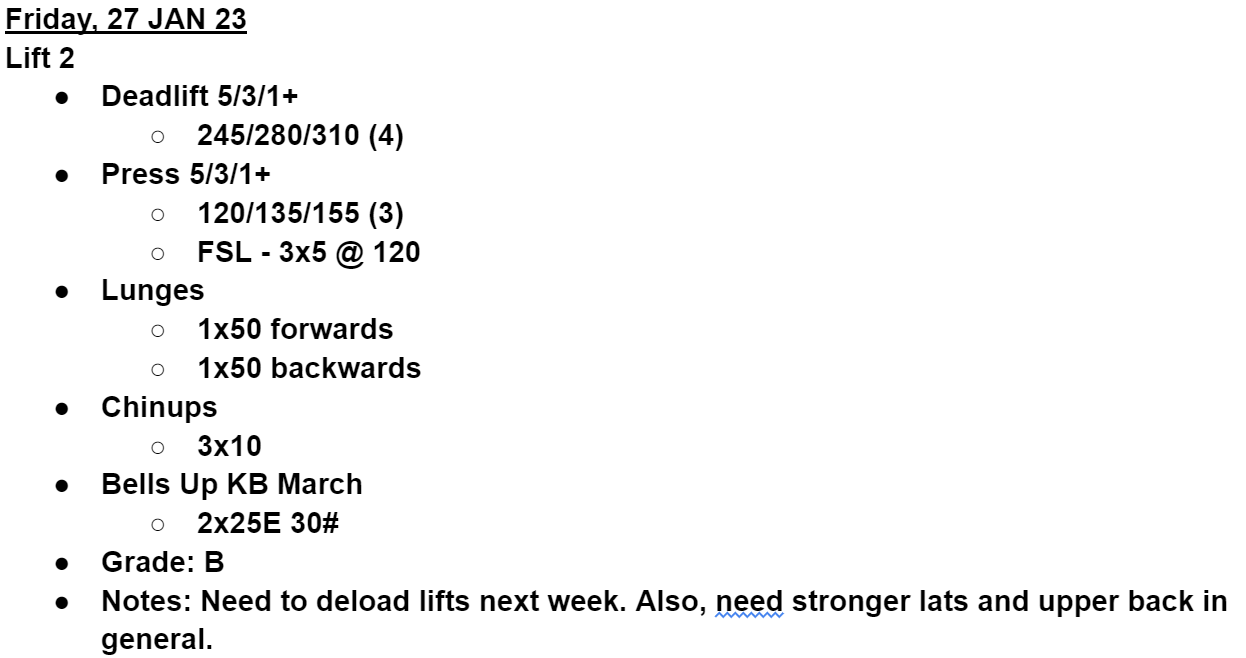Tools to Track Progress
You Have to Know Where You've Been to Know Where You're Going
This week, I wanted to touch on an important topic that I highlighted in a post from early 2023: keeping a training log.
If you care about growth and improvement in any area — health, athletics, business, personal finance, etc. — it’s essential to keep track of your progress. If we don’t record data, conduct honest self-assessments, and recalibrate or set new goals and strategies to move forward with, we’re simply floating around with the hope that success or growth will find us.
When it comes to my training (lifting weights and running), it’s important for me to look back at how I’ve performed in the past (weights, reps, sets, miles, speed, heart rate, etc.) to determine if my performance is trending in the right direction.
I record all of my training on a Google Doc or Google Sheets file. While I love to physically write things out in pen or pencil, I’ve found the Google option to work best because I pretty much always have my phone with me, the information is backed up to my Google Drive, and it’s easy to share or email. I have a few files that I use on a regular basis to track my training. That may seem a bit excessive, but they all have their purpose.
Daily Training Log - I record all of my training–both strength and endurance work–in my training log Google Doc. For lifts, I’ll include movements, sets, reps, and weights. For runs, I will enter the distance, time, pace, elevation gain, heart rate, cadence, weather, and route. Another advantage of using the Google Doc over a written notebook is that I can easily search for a movement or route in a previous workout and compare data (i.e. weight lifted or speed/mileage ran) to ensure I’m progressing appropriately. I find that extremely helpful for building on my assistance exercises like rows or leg extensions; every powerlifter knows how much they deadlifted last week, but it’s also important to track and progress the accessory movements. For both strength and endurance workouts, I will include a grade and notes on how the session went. I adopted my grading scale from Training for the Uphill Athlete.
A - means you felt like Superman and had plenty in reserve.
B - means it was a good workout. You completed the task no problem.
C - means you did the workout but felt flat or off.
D - means you could not finish the planned workout or had to reduce it.
F - means you could not train that day due to fatigue or illness.
By grading each workout this way, you can make a quick scan of your training log over the previous few weeks and see trends or patterns. A good rule of thumb is that if you have more than two Cs in a row, or a C and a D within one week, you need to stop and assess what is going on.
In addition to logging individual workouts, I will enter a “weekly wrap” each Sunday evening. This summary includes my sleep, resting heart rate, body weight, running volume, and notes for the training week. That brings me to my next document…
Training Week Metrics Spreadsheet - This is nothing more than a spreadsheet that displays the data from my “weekly wraps” in a way that I can monitor these metrics over time. Glancing at this each week ensures that I’m progressing appropriately in running volume as I approach my race, but it transcends mere performance. Unexplained fluctuations in resting heart rate, weight, or sleep could be indicators of potential health problems. Fortunately, all my metrics look to be pretty stable. As you can see, my sleep really sucked back in October when I had the flu and I had a small jump in resting heart rate in January when I was on a ski trip at high altitude.
Lift Maxes - I take a conjugate approach to strength training, so I end up doing a lot of different variations of squats, presses, and deadlifts. Again, a powerlifter can always remember their best “competition-style” squat, bench, and deadlift, but very few have their "12-inch block pull against orange bands” or “3-rep max bench press with chains” numbers memorized. So, I keep a basic spreadsheet in Google Sheets with 1, 2, and 3-rep maxes of all my different variations recorded. That way, if my program calls for a certain percentage or tells me to max out on one of these variations, I can quickly reference what I hit before.
5/3/1 Spreadsheet - I’m not currently using a 5/3/1 strength training template, but for when I do, I keep this spreadsheet. I’ve been using this template for over 7 years. Its cells are formulated to spit out appropriate training weights for my three-week 5/3/1 cycles based on my training maxes for the squat, bench press, deadlift, and overhead press. I simply add another tab and change the training max as needed each time I’m ready to start a new cycle. Like with my daily training log, it’s easy to access historical data. Sometimes I’ll jot down the accessory exercises I plan on doing at the bottom. I also have a tab with all of my “rep PRs” on the main lifts. You can utilize this spreadsheet approach for any percentage-based strength program, not just 5/3/1. Just make sure to double check your formulas, or you may get a nasty surprise when your spreadsheet tells you to lift 95% of your training max for 5 reps.










